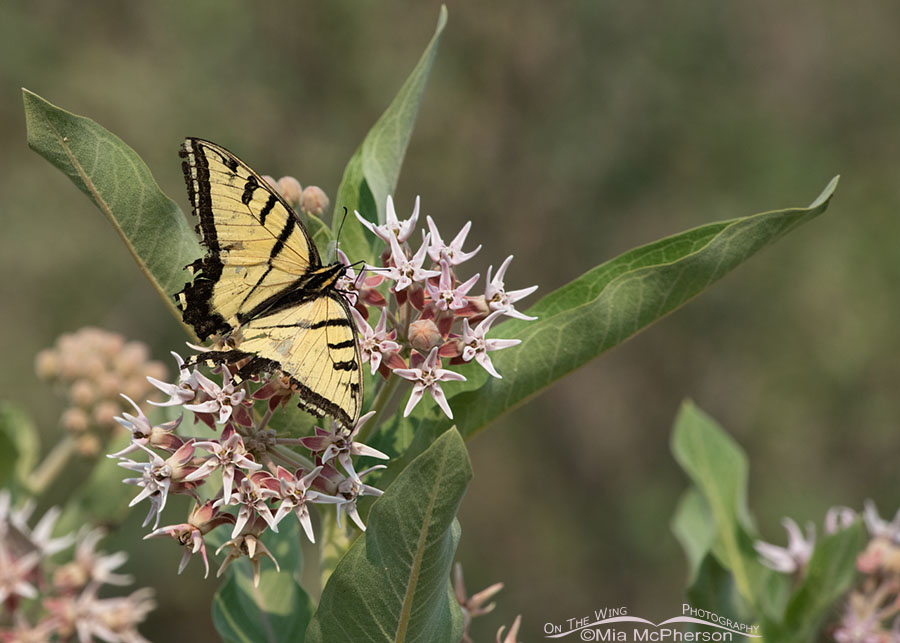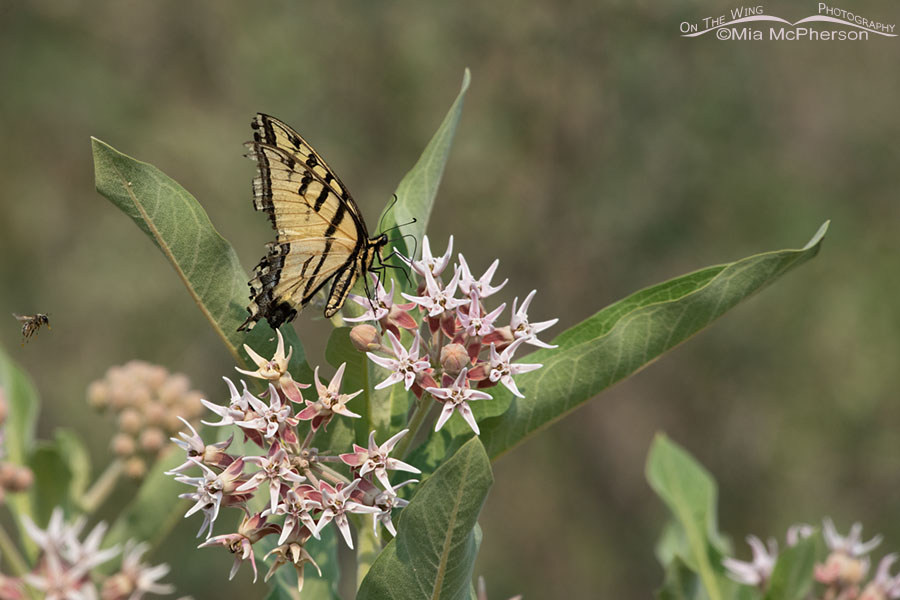 Two-tailed Swallowtail on Showy Milkweed – Nikon D810, f7.1, 1/2000, ISO 500, Nikkor 500mm VR with 1.4x TC, natural light
Two-tailed Swallowtail on Showy Milkweed – Nikon D810, f7.1, 1/2000, ISO 500, Nikkor 500mm VR with 1.4x TC, natural light
Two days ago I stopped at a clump of blooming plants in mountain forest because I had spotted a butterfly nectaring on them and I wanted to photograph it.
What is it?
I was asked what it was while I photographed the striking yellow and black butterfly and I said that it was a swallowtail but that I wasn’t certain of the species. When I am in the field I focus on the subject and if I don’t know precisely what it is I don’t stop what I am doing to identify it. I know that many of my subjects will be gone soon so I focus on them. There is time later to make a positive identification if I get decent photos which means I make that my priority.
When I returned home and could view my images on a large screen I was able to identify this swallowtail butterfly as a male Two-tailed Swallowtail. Even though this particular swallowtail is pretty battered looking and was missing the features that give this species its common name using the markings on the fore and hindwings it was fairly easy to identify. If this specimen had been in better shape the two tails that give this species its common name would have been visible.
During my research I learned that the female Two-tailed Swallowtail butterflies lay their eggs in the abundant chokecherry trees found in the Wasatch Mountains. Now I want to find the caterpillars of this species.
 Two-tailed Swallowtail nectaring on Showy Milkweed – Nikon D810, f7.1, 1/1600, ISO 500, Nikkor 500mm VR with 1.4x TC, natural light
Two-tailed Swallowtail nectaring on Showy Milkweed – Nikon D810, f7.1, 1/1600, ISO 500, Nikkor 500mm VR with 1.4x TC, natural light
What is the flower the butterfly is on?
The wildflower that the adult Two-tailed Swallowtail is nectaring on is a Showy Milkweed. I have found Showy Milkweeds high in the Wasatch Mountains, on Antelope Island, the marshes of Bear River Migratory Bird Refuge, and in arid locations of the desert. It is a showy native plant that is beneficial for many bees, butterflies, and other insects. The first time I photographed this unforgettable wildflower was in July of 2008 on a visit to Antelope Island which was before I had moved to Utah.
I would have loved to have sat at that clump of Showy Milkweed to see what other butterflies might have flown in. Another day perhaps but it will have to be soon because the milkweed flowers are already fading fast.
Life is good.
Mia
Click here to see more of my wildflower photos along with shrubs and trees. Click here to see more of my insect and spider images.


Mia, what is the difference between this butterfly and a Tiger Swallowtail? Can’t seem to find Two-tailed Swallowtail.
Dick, Tiger Swallowtails can be found east of the Great Plains states, Two-tailed Swallowtails are western swallowtails. I linked to information on this species in the first section of my post but for more information you might want to check out this link: https://www.butterfliesandmoths.org/species/Papilio-multicaudata
Lovely, scruffy butterfly.
Thanks for this little glimpse into the wilderness – and thanks to commenter Liz who pointed out the bee!
Your usual excellent work, Mia! As someone old and battered, I am pleased to see that you include all forms of things that you see and shoot (LOL).
Thank you for your all encompassing scope on the wild things.
Very nice as always. It is a battered butterfly!
Hi Mia I have been enjoying your photos especially these of the butterflies as I have been seeing a lot of swallowtails and admirals in the mountains. I am off out Facebook since my family and friends have mostly left. I am still on Instagram where I can interact with them. I still follow you via email and will because I love your daily dose of inspiration.
The bee in the left of the second photo looks like it is waiting its turn to get some nectar. Beautiful images as usual.